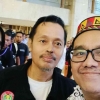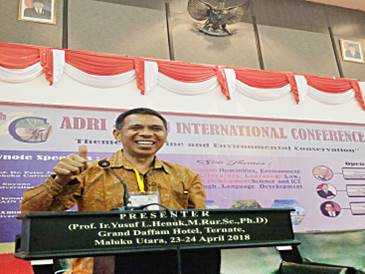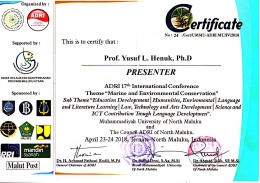Penulis dan semua koleganya mengawali kegiatan ilmiah mereka tahun 2018 lewat mengirim abstrak mereka berjudul seperti terbaca dibawah ini dan diterima (accepted) oleh panitia dari http://ocs.p-adri.or.id/index.php/ic17/ic17):
The integrated farming systems between cattle and oil palm plantation in Indonesia
Y L Henuk1*, Hasnudi1 , Yunilas1, N Ginting1, E Mirwandhono1, Hasanuddin1, J Ginting1, D Bakti1, Rosmayati, E Purba1, H Hafid2, and M M J Kapa3
1Faculty of Agriculture, Universitas Sumatera Utara, Medan 20155 Indonesia
2Faculty of Animal Science, University of Halu Oleo, Kampus Hijau Bumi Tridharma
Anduonohu, Kendari 93232 Indonesia
3Faculty of Agriculture, University of Nusa Cendana, Kupang 85361 Indonesia
*Corresponding/presenting author: yusufhenuk62@live.com.
Abstract. Ruminant-oil palm plantation integration is one of agricultural practices, which commonly applied in Indonesia since the introduction of a "Sistem Integrasi Sapi - Kelapa Sawit" (SISKA) or "System Integration Cattle --Oil Palm Plantations" in 2011. In this production system, grasses species in oil palm plantation are potential forage source for development of cattle production in Indonesia. There are around 12 million ha of oil palm plantations in Indonesia divided into three parts: (1) private plantation enterprise (52%), (2) small-holder's plantation enterprise (41.42%) and (3) state-own plantation enterprise (6.72%) owned by foreign companies.
Oil palm plantation has been spread out in 25 provinces of Indonesia, but mostly in Sumatera and Kalimantan with a total CPO production of 33.5 million tons. In addition to producing CPO as the mainstay, the oil palm plantation produces several forage grasses and legumes for cattle grazing as well as oil palm industry produces types of by-products potential to be used as animal feed, namely palm press fiber (PPF), mud palm sludge (PS), oil palm frond (OPF) and palm oil trunk (POS) obtained from palm oil plantations.











